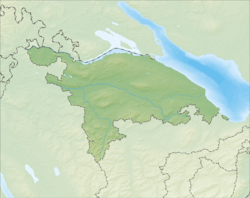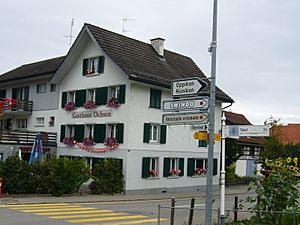Amlikon-Bissegg facts for kids
Quick facts for kids
Amlikon-Bissegg
|
||
|---|---|---|

Amlikon village
|
||
|
||
| Country | Switzerland | |
| Canton | Thurgau | |
| District | Weinfelden | |
| Area | ||
| • Total | 14.46 km2 (5.58 sq mi) | |
| Elevation | 422 m (1,385 ft) | |
| Population
(Dec 2020 )
|
||
| • Total | 1,332 | |
| • Density | 92.12/km2 (238.58/sq mi) | |
| Postal code |
8514
|
|
| Localities | Amlikon, Bissegg, Holzhäusern, Hünikon, Junkholz, Griesenberg, Altenburg, Bänikon, Fimmelsberg, Holzhof, Leutmerken, Tümpfel, Strohwilen | |
| Surrounded by | Affeltrangen, Bussnang, Hüttlingen, Märstetten, Müllheim, Thundorf, Weinfelden, Wigoltingen | |
Amlikon-Bissegg is a small town, also called a municipality, in Switzerland. It is located in the canton of Thurgau, within the Weinfelden district.
This municipality was formed on January 1, 1995. It was created by joining four smaller places: Amlikon, Bissegg, Griesenberg, and Strohwilen.
Contents
History of Amlikon-Bissegg
The village of Amlikon was first mentioned in old records in 1282. The small settlement, or hamlet, of Bissegg appeared in records in 1324. Bissegg also includes other hamlets like Holzhäusern, Hünikon, and Junkholz. The village of Griesenberg was first mentioned in 1256.
Amlikon's Past
For a long time, Amlikon was part of the Griesenberg area. This area was controlled by a powerful family called the Bussnang family. Amlikon has always been part of the local church area, or parish, of Bussnang.
A ferry used to cross the Rhine River in Amlikon, first mentioned in the 1300s. Around 1727, a bridge replaced the ferry. A big flood in 1910 destroyed a covered bridge built in 1821. A new iron bridge was built in 1911-12, and then a modern concrete bridge in 1995. The town is located on both sides of the Thur River.
In the past, people in Amlikon mostly grew grain using a system where fields were rotated. They also grew hemp. Later, in the 1800s, people started raising cattle and making dairy products. The first cheese factory opened in 1908. Today, some wine grapes are grown there.
Bissegg's Story
Much of Bissegg used to belong to a powerful monastery called the Abbey of St. Gallen. Like Amlikon, it was also influenced by the Bussnang family. Bissegg was part of the Bussnang church parish for many years. Later, in 1857, Bissegg and Junkholz joined the Reformed church parish of Leutmerken.
The economy in Bissegg also focused on growing grain. Some vineyards were present too. In the 1800s, farming changed to raising cattle and producing dairy. A cheese factory finally opened in Bissegg in 1905.
Griesenberg's History
Griesenberg was also originally owned by the Abbey of St. Gallen. It was important to the Bussnang family. The area had a fortress called Alt-Griesenberg, which was destroyed in 1289. A new center was then built at Neu-Griesenberg castle.
Over the centuries, Griesenberg was owned by different families. In 1529, it was bought by Henry of Ulm. The church in Griesenberg was part of the Leutmerken parish. It became Protestant during the Reformation in 1529. However, when Marx von Ulm changed back to the old religion in 1607, the Counter-Reformation brought the old religion back to the village.
Like the other areas, Griesenberg's economy was based on growing grain. This later changed to raising livestock and dairy farming. Fruit growing also became important. The Holzhof farm in Griesenberg is famous for being one of the places where Tilsit cheese was first made in Switzerland.
Geography of Amlikon-Bissegg
Amlikon-Bissegg covers an area of about 14.43 square kilometers (about 5.57 square miles). Most of this land, about 68.5%, is used for farming. Forests cover about 22.2% of the area.
About 8.2% of the land is built up with buildings and roads. A small part, about 1.2%, is made up of rivers or lakes. Very little of the land is unproductive.
The municipality is located on the left side of the Thur River. It sits along the road that connects Konstanz and Wil. Amlikon-Bissegg includes the main villages of Amlikon, Griesenberg, and Strohwilen. It also has many smaller hamlets like Bissegg, Holzhäusern, Hünikon, Junkholz, and others.
People of Amlikon-Bissegg (Demographics)
Amlikon-Bissegg has a population of about 1,223 people (as of December 2007). A small part of the population, about 7%, are people from other countries. Over the last ten years, the population has grown by about 9.5%.
Most people in Amlikon-Bissegg speak German, about 97.4%. A few people speak French or Polish.
In 2008, there were slightly more men (51.6%) than women (48.4%) living in the municipality. The population changes each year due to births, deaths, and people moving in or out. In 2008, the total population grew by about 2%.
The age groups in Amlikon-Bissegg show that about 9.7% of the people are children under 9 years old. Teenagers (10-19 years old) make up about 16.8% of the population. Adults between 20 and 59 years old make up a large part of the population. Older adults (60 and above) make up about 18.2% of the population.
In 2000, there were 412 homes in the municipality, with about 2.9 people living in each home on average. Most of the buildings were single-family homes.
In the 2007 national election, the most popular political party was the SVP. They received about 57.87% of the votes.
The table below shows how the population has changed over time in Amlikon, Bissegg, Griesenberg, and then for the combined Amlikon-Bissegg:
| Year | Population Amlikon |
Population Bissegg |
Population Griesenberg |
|---|---|---|---|
| 1850 | 278 | – | 500 |
| 1870 | – | 205 | – |
| 1900 | 303 | 187 | 438 |
| 1920 | – | 138 | – |
| 1950 | – | 153 | 397 |
| 1960 | 258 | 161 | – |
| 1990 | 352 | 185 | 352 |
| Year | Population, Amlikon-Bissegg | ||
| 2000 | 1,199 | ||
Places to See
The entire hamlet of Leutmerken and the area called Griesenberg are special. They are recognized as important Swiss heritage sites. This means they have historical or cultural value.
Economy and Jobs
In 2007, Amlikon-Bissegg had a low unemployment rate of 1.24%. This means most people who wanted to work had jobs.
In 2005, many people worked in the primary economic sector. This includes jobs like farming and forestry. There were 72 businesses in this area. About 73 people worked in the secondary sector, which includes manufacturing and construction. There were 14 such businesses. The largest number of people, 150, worked in the tertiary sector. This includes jobs in services like shops, restaurants, and offices. There were 40 businesses in this sector.
Many people who live in Amlikon-Bissegg travel to other towns for work. About 44% of the residents work outside the municipality. At the same time, 114 people travel into Amlikon-Bissegg for their jobs. Most people use a private car to get to work, about 49%.
Religion in Amlikon-Bissegg
Based on the 2000 census, about 29.1% of the people in Amlikon-Bissegg were Roman Catholic. A larger group, about 54.5%, belonged to the Swiss Reformed Church.
A smaller number of people belonged to other Christian churches, or to the Islamic faith. About 7.09% of the population said they did not belong to any church or religion.
Education
Education is important in Amlikon-Bissegg. About 72.5% of adults (between 25 and 64 years old) have finished high school or gone on to higher education, like university.
Amlikon-Bissegg has its own primary school district. In the 2008/2009 school year, there were 58 students in total. This included 10 children in kindergarten. The average class size in primary school was 16 students.
See also
 In Spanish: Amlikon-Bissegg para niños
In Spanish: Amlikon-Bissegg para niños






